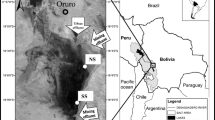Abstract
Preliminary studies of mercury (Hg) cycling in the Everglades revealed that dissolved gaseous mercury (DGM), total mercury (HgT), and reactive mercury (HgR) show reproducible, diel trends. Peak water-column DGM concentrations were observed on or about noon, with a 3 to 7 fold increase over night-time concentrations. Production of DGM appears to cease during dark periods, with nearly constant water column concentrations that were at or near saturation with respect to the overlying air. A simple mass balance shows that the flux of Hg to the atmosphere from diel DGM production and evasion represents about 10% of the annual input from atmospheric deposition. Production of DGM is likely the result of an indirect photolysis reaction that involves the production of reductive species and/or reduction by electron transfer. Diel variability in HgT and HgR appears to be controlled by two factors: inputs from rainfall and photolytic sorption/desorption processes. A possible mechanism involves photolysis of chromophores on the surface of a solid substrate (e.g., the periphyton mat) giving rise to destabilization of sorbed mercury and net desorption during daylight. At night, the sorption reactions predominate and the water-column HgT decreases. Methylmercury (MeHg) also showed diel trends in concentration but were not clearly linked to the solar cycle or rainfall at the study site.
Similar content being viewed by others
References
Amyot M, Mierle G, Lean DRS & McQueen DJ (1994) Sunlight-induced formation of dissolved gaseous mercury in lake waters. Environ. Sci. Technol. 28: 2366–2371
Amyot M, Mierle G, Lean DRS & McQueen DJ (1997) Effect of solar radiation on the formation of dissolved gaseous mercury in temperate lakes. Geoch. Cosmo. Acta 61: 975–987
Bloom NS & Fitzgerald WF (1987) Determinatin of volatile mercury species at the picogram level by low temperature gas chromatography with cold-vapor atomic fluorescence detection. Anal. Chim Acta 208: 151–161
Cleckner LB, Garrison PJ, Hurley JP, Olson ML & Krabbenhoft DP (this issue) Trophic transfer of methylmercury in the northern Everglades. Biogeochemistry
Davis JH Jr (1943) The natural features of southern Florida, especially the vegetation, and the Everglades. Flor. Geol. Surv. Geol. Bull. (25)
Dvonch JT, Vette AF, Keeler GJ, Evans G & Stevens R (1995) An intensive multi-site pilot study investigating atmospheric mercury in Broward County, Florida. Water Air Soil Poll. 80: 169–178
Gill GA, Guentzel JL, Landing WM & Pollman CD (1995) Total gaseous mercury measurements in Florida: The FAMS project (1992–1994). Water Air Soil Poll. 80: 235–244
Guentzel JL, Landing WM, Gill GA & Pollman CD (1995) Atmospheric deposition of mercury in Florida: The FAMS project (1992–1994). Water Air Soil Poll. 80: 393–402
Horvat M, Liang L & Bloom NS (1993) Comparison of distillation with other current isolation methods for the determination of methyl mercury compounds in low level environmental samples. Anal. Chim. Acta 282: 153–168
Hurley JP, Krabbenhoft DP, Cleckner LB, Olson ML, Aiken G & Rawlik PJ (this issue) System controls on aqueous mercury distribution in the northern Everglades. Biogeochemistry
Jordan, D. (1990) Mercury Contamination: Another Threat to the Florida Panther. Endangered Species Technical Bulletin, U.S. Fish and Wildlife Service 15(2) (pp 1–2). Washington, DC
Krabbenhoft DP (1996) Mercury Studies in the Florida Everglades, U.S. Geological Survey Fact Sheet, FS-166-96 (4 p)
Lindberg SE, Meyers TP & Munthe J (1995) Evasion of mercury vapor from the surface of a recently limed acid forest lake in Sweden. Water Air Soil Poll. 85: 725–730
McCormick PV, Rawlik PS, Lurding K, Smith EP & Sklar FH (1996) Periphyton-water quality relationships along a nutrient gradient in the northern Florida Everglades. J. N. Am. Benthol. Soc. 5: 433–449.
Miller GC & Zepp RG (1979) Photoreactivity of aquatic pollutants sorbed on suspended sediments. Environ. Sci. Technol. 13: 860–873
Olson ML, Cleckner LB, Hurley JP, Krabbenhoft DP & Heelan TW (1997) Resolution of matrix effects on analysis of total and methyl mercury in aqueous samples from the Florida Everglades. Fresenius J. Anal. Chem. 358: 392–396
Roelke ME, Schultz DP, Facemire CF, Sundlof SF & Royals HE (1991) Mercury Contamination in Florida Panthers. Report of the Florida Panther Technical subcommittee to the Florida Panther Interagency Committee, Gainesville, FL
Schroeder WH, Yarwood G & Niki H (1991) Transformation processes involving mercury species in the atmosphere: Results from a literature survey. Water Air Soil Poll. 56: 653–666
Schwarzenbach RP, Gschwend GW & Imboden DM (1993) Environmental Organic Chemistry. John Wiley & Sons, Inc., New York, 681 p
Sellers P, Kelly CA, Rudd JWM & MacHutchon AR (1996) Photodegradation of methylmercury in lakes. Nature 380: 694–697
Sexaver-Gustin M & Taylor GW (1006), Light Induced Flux of Mercury from Substrate. Fourth International Conference on Mercury as a Global Pollutant, August 4–8. Hamburg, Germany, p 137
Spalding MG, Bjork RD, Powell GVN & Sundlof SF (1994) Mercury and cause of death in Great White Herons. J. Wildl. Manage. 58: 735–739
Stober QJ, Jones RD & Scheidt DJ (1995) Ultra trace level mercury in the Everglades ecosystem, a multi-media canal pilot study. Water Air Soil Poll. 80: 991–1001
Sundlof SF, Spalding MG, Wentworth JD & Steible CK (1994) Mercury in livers of wading birds (Ciconiformes) in southern Florida. Arch. Environ. Contam. Toxicol. 27: 299–305
Vaithiyanathan P, Richardson CJ, Kavanaugh RG, Craft CB & Barkay TB (1996) Relationships of eutrophication to the distribution of mercury and to the potential for methylmercury production in the peat soils of the Everglades. Environ. Sci. Technol. 30: 2591–2597
Ware FJ, Royals H & Lange T (1990) Proceedings of the Annual Conference of the Southeastern Association of Fish and Wildlife Agencies 44 (pp 5–12).
Zafiriou OC, Joussot-Dubien J, Zepp RG & Zika RG (1984) Photochemistry of natural waters. Environ. Sci. Technol. 18: 358A–371A
Zepp RG & Wolfe NL (1987) Abiotic transformation of organic chemicals at the particle-water interface. In: Stumm W (Ed) Aquatic Surface Chemistry. Wiley-Interscience, New York
Rights and permissions
About this article
Cite this article
Krabbenhoft, D.P., Hurley, J.P., Olson, M.L. et al. Diel variability of mercury phase and species distributions in the Florida Everglades. Biogeochemistry 40, 311–325 (1998). https://doi.org/10.1023/A:1005938607225
Issue Date:
DOI: https://doi.org/10.1023/A:1005938607225



